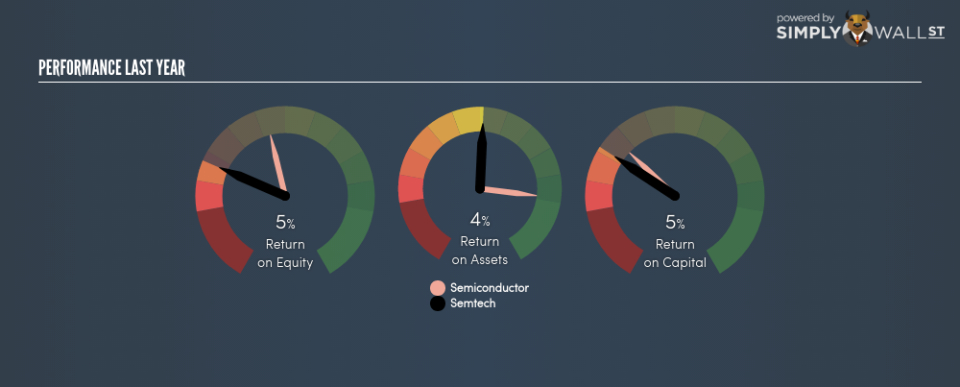With An ROE Of 5.34%, Can Semtech Corporation (NASDAQ:SMTC) Catch Up To The Industry?

This analysis is intended to introduce important early concepts to people who are starting to invest and want a simplistic look at the return on Semtech Corporation (NASDAQ:SMTC) stock.
Semtech Corporation (NASDAQ:SMTC) delivered a less impressive 5.34% ROE over the past year, compared to the 13.83% return generated by its industry. Though SMTC’s recent performance is underwhelming, it is useful to understand what ROE is made up of and how it should be interpreted. Knowing these components can change your views on SMTC’s below-average returns. Today I will look at how components such as financial leverage can influence ROE which may impact the sustainability of SMTC’s returns. Check out our latest analysis for Semtech
What you must know about ROE
Return on Equity (ROE) is a measure of Semtech’s profit relative to its shareholders’ equity. For example, if the company invests $1 in the form of equity, it will generate $0.053 in earnings from this. Generally speaking, a higher ROE is preferred; however, there are other factors we must also consider before making any conclusions.
Return on Equity = Net Profit ÷ Shareholders Equity
ROE is measured against cost of equity in order to determine the efficiency of Semtech’s equity capital deployed. Its cost of equity is 10.27%. Given a discrepancy of -4.93% between return and cost, this indicated that Semtech may be paying more for its capital than what it’s generating in return. ROE can be dissected into three distinct ratios: net profit margin, asset turnover, and financial leverage. This is called the Dupont Formula:
Dupont Formula
ROE = profit margin × asset turnover × financial leverage
ROE = (annual net profit ÷ sales) × (sales ÷ assets) × (assets ÷ shareholders’ equity)
ROE = annual net profit ÷ shareholders’ equity
Essentially, profit margin shows how much money the company makes after paying for all its expenses. Asset turnover shows how much revenue Semtech can generate with its current asset base. Finally, financial leverage will be our main focus today. It shows how much of assets are funded by equity and can show how sustainable the company’s capital structure is. Since financial leverage can artificially inflate ROE, we need to look at how much debt Semtech currently has. The debt-to-equity ratio currently stands at a low 32.15%, meaning Semtech still has headroom to borrow debt to increase profits.
Next Steps:
ROE is one of many ratios which meaningfully dissects financial statements, which illustrates the quality of a company. Semtech’s ROE is underwhelming relative to the industry average, and its returns were also not strong enough to cover its own cost of equity. Although, its appropriate level of leverage means investors can be more confident in the sustainability of Semtech’s return with a possible increase should the company decide to increase its debt levels. Although ROE can be a useful metric, it is only a small part of diligent research.
For Semtech, I’ve compiled three fundamental aspects you should further research:
Financial Health: Does it have a healthy balance sheet? Take a look at our free balance sheet analysis with six simple checks on key factors like leverage and risk.
Valuation: What is Semtech worth today? Is the stock undervalued, even when its growth outlook is factored into its intrinsic value? The intrinsic value infographic in our free research report helps visualize whether Semtech is currently mispriced by the market.
Other High-Growth Alternatives : Are there other high-growth stocks you could be holding instead of Semtech? Explore our interactive list of stocks with large growth potential to get an idea of what else is out there you may be missing!
To help readers see pass the short term volatility of the financial market, we aim to bring you a long-term focused research analysis purely driven by fundamental data. Note that our analysis does not factor in the latest price sensitive company announcements.
The author is an independent contributor and at the time of publication had no position in the stocks mentioned.


